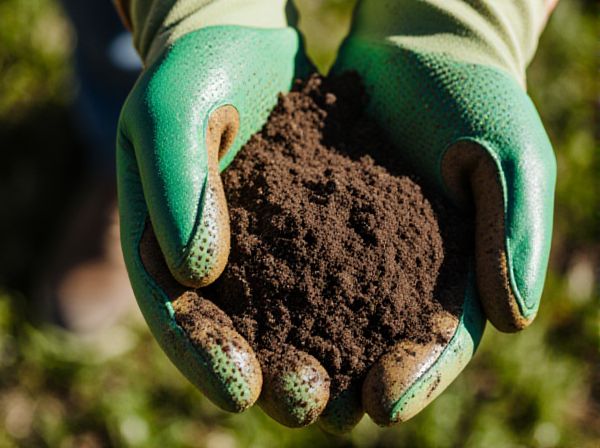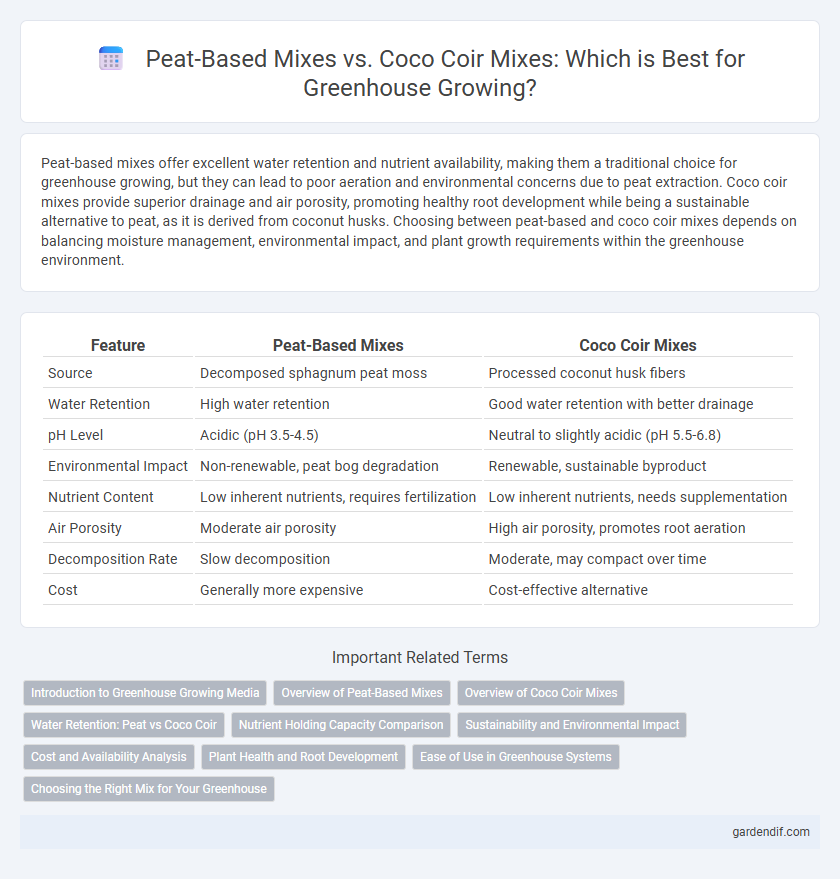
Peat-based mixes vs coco coir mixes Illustration
Peat-based mixes offer excellent water retention and nutrient availability, making them a traditional choice for greenhouse growing, but they can lead to poor aeration and environmental concerns due to peat extraction. Coco coir mixes provide superior drainage and air porosity, promoting healthy root development while being a sustainable alternative to peat, as it is derived from coconut husks. Choosing between peat-based and coco coir mixes depends on balancing moisture management, environmental impact, and plant growth requirements within the greenhouse environment.
Table of Comparison
| Feature | Peat-Based Mixes | Coco Coir Mixes |
|---|---|---|
| Source | Decomposed sphagnum peat moss | Processed coconut husk fibers |
| Water Retention | High water retention | Good water retention with better drainage |
| pH Level | Acidic (pH 3.5-4.5) | Neutral to slightly acidic (pH 5.5-6.8) |
| Environmental Impact | Non-renewable, peat bog degradation | Renewable, sustainable byproduct |
| Nutrient Content | Low inherent nutrients, requires fertilization | Low inherent nutrients, needs supplementation |
| Air Porosity | Moderate air porosity | High air porosity, promotes root aeration |
| Decomposition Rate | Slow decomposition | Moderate, may compact over time |
| Cost | Generally more expensive | Cost-effective alternative |
Introduction to Greenhouse Growing Media
Peat-based mixes offer excellent water retention and nutrient holding capacity, making them a traditional choice for greenhouse growing media. Coco coir mixes provide superior aeration and sustainable sourcing, promoting healthy root development and reducing environmental impact. Selecting the appropriate media depends on crop requirements, water management, and sustainability goals in greenhouse production systems.
Overview of Peat-Based Mixes
Peat-based mixes consist primarily of decomposed sphagnum moss harvested from peat bogs, offering excellent water retention and aeration properties essential for greenhouse plant growth. These mixes provide a slightly acidic pH, which benefits most greenhouse crops by enhancing nutrient availability and microbial activity in the root zone. Despite their effectiveness, peat-based substrates raise environmental concerns due to peat extraction's impact on carbon emissions and ecosystem disruption.
Overview of Coco Coir Mixes
Coco coir mixes offer superior aeration and water retention compared to peat-based mixes, promoting healthier root development in greenhouse plants. Derived from coconut husks, coco coir is a renewable resource that provides an eco-friendly alternative to non-renewable peat, reducing environmental impact. Its natural resistance to fungal diseases and balanced pH make coco coir mixes ideal for a wide range of horticultural applications.
Water Retention: Peat vs Coco Coir
Peat-based mixes have high water retention due to their fine texture and organic matter, allowing them to hold moisture for extended periods and reduce frequent watering. Coco coir mixes also offer excellent water retention but provide better aeration and drainage compared to peat, preventing waterlogging and root rot. In greenhouse cultivation, choosing peat or coco coir depends on balancing moisture needs with optimal root oxygenation for healthy plant growth.
Nutrient Holding Capacity Comparison
Peat-based mixes exhibit a higher nutrient holding capacity due to their fine texture and significant cation exchange capacity, enabling better retention and gradual release of essential nutrients to plants. Coco coir mixes offer improved aeration and water retention but generally have a lower nutrient holding capacity, requiring more frequent fertilization to maintain optimal plant growth. Comparing nutrient retention rates, peat-based substrates typically retain up to 80% of nutrients, whereas coco coir retains around 60%, influencing fertilization schedules in greenhouse production.
Sustainability and Environmental Impact
Peat-based mixes contribute to significant environmental concerns due to peatland degradation, releasing stored carbon and disrupting ecosystems. Coco coir mixes offer a sustainable alternative by utilizing a renewable resource with lower carbon emissions and enhanced water retention, reducing overall environmental impact. Transitioning to coco coir supports biodiversity conservation and aligns with sustainable greenhouse practices.
Cost and Availability Analysis
Peat-based mixes typically have higher initial costs due to limited natural reserves and extraction expenses, whereas coco coir mixes offer a more sustainable and often cost-effective alternative with widespread availability in tropical regions. The price volatility of peat is influenced by environmental regulations and transportation logistics, while coco coir benefits from the global coconut industry's byproduct supply chain. For greenhouse growers, coco coir provides consistent quality and bulk purchasing options that can reduce overall substrate expenses compared to peat-based mixes.
Plant Health and Root Development
Peat-based mixes provide excellent water retention and acidity levels conducive to healthy plant growth, promoting robust root development through improved aeration and nutrient availability. Coco coir mixes offer superior drainage and aeration, reducing the risk of root rot while supporting healthy microbial activity essential for nutrient uptake. Studies show coco coir enhances root mass and overall plant vigor, making it a sustainable alternative to peat-based substrates in greenhouse cultivation.
Ease of Use in Greenhouse Systems
Peat-based mixes offer consistent moisture retention and nutrient availability, making them straightforward for greenhouse irrigation systems to manage. Coco coir mixes provide superior aeration and quicker drainage, reducing risks of root rot and facilitating faster plant growth cycles. Both media types support automated watering strategies, but peat-based mixes generally require less frequent adjustments due to their water-holding capacity.
Choosing the Right Mix for Your Greenhouse
Peat-based mixes offer excellent water retention and nutrient availability, making them ideal for moisture-loving plants in greenhouses. Coco coir mixes provide superior aeration and drainage, supporting healthy root growth and reducing the risk of root rot in high-humidity environments. Selecting the right mix depends on plant species, watering frequency, and environmental conditions within your greenhouse to optimize growth and yield.
Peat-based mixes vs coco coir mixes Infographic

 gardendif.com
gardendif.com